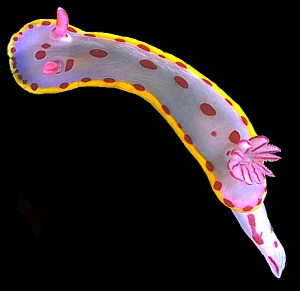
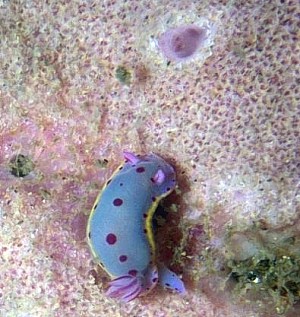
Hypselodoris bennetti
(Angas, 1864)
Order: NUDIBRANCHIA
Suborder: DORIDINA
Family: Chromodorididae
DISTRIBUTION
Southeastern Australia from southern Queensland in the north to eastern Victoria in the south. [any records from Victoria would be welcome].
PHOTO
UPPER: Twofold Bay, southern New South Wales, March 1986, 26mm long.
LOWER: Providential Head, Wattamolla Bay, New South Wales, on food sponge, Psammocinia sp (Thorectidae, Dictyoceratida).
PHOTOS: Bill Rudman.
Grows to about 50mm in length but usually 35mm or less. The bright yellow eggs are large, indicative of its direct developing larvae. Hypselodoris bennetti usually has a row of red spots down the dorsal midline but sometimes the spots are arranged randomly all over the dorsum. Its food sponge, Psammocinia sp. is hard and rough to touch, incorporating sand grains into it skeletal structure. Often the sponge is overgrown with algae and unrecognisable as a sponge, leading to the mistaken belief that this chromodorid is usually found away from its food.
There are many red and orange-spotted species of chromodorid in New South Wales and southeastern Australia. I have discussed this example of mimicry on a separate page.
References:
• Rudman, W.B. (1983a) The Chromodorididae (Opisthobranchia: Mollusca) of the Indo-West Pacific: Chromodoris splendida, C. aspersa and Hypselodoris placida colour groups. Zoological Journal of the Linnean Society 78: 105-173.
• Rudman, W.B. (1991) Purpose in Pattern: the evolution of colour in chromodorid nudibranchs. Journal of Molluscan Studies, 57, (T.E. Thompson Memorial Issue): 5-21.
Rudman, W.B., 1999 (June 1) Hypselodoris bennetti (Angas, 1864). [In] Sea Slug Forum. Australian Museum, Sydney. Available from http://www.seaslugforum.net/find/hypsbenn
Related messages
Re: Hypselodoris bennetti mating
February 5, 2008
From: Leanne & David Atkinson
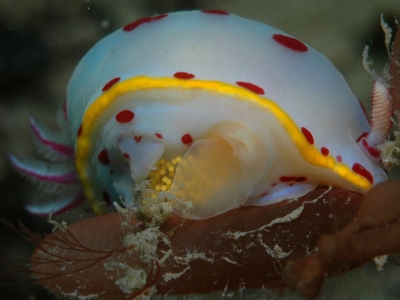
Concerning message #11887:
Dear Bill,
Here are some photos of Hypselodoris bennetti laying eggs. They are a very common nudibranch all year round in Port Stephens and despite taking many photos of them breeding these are the first photos we have taken of one laying eggs. Although you describe the eggs in the Fact Sheet you don't seem to have a photo and these show the eggs leaving the oviduct so there can be no doubt as to the nudibranch laying them. Hope these photos are of interest.
Locality: The Pipeline, Nelson Bay, Port Stephens, 8 metres, New South Wales, Australia, Pacfic, 12 January 2008, Silty sandy bottom with seagrass, algae, scattered sponges, ascidians, bryozoans, gorgonians and soft corals. Length: approximately 35 mm. Photographer: Leanne & David Atkinson.
Regards,
Leanne & David Atkinson
atk@hunterlink.net.au
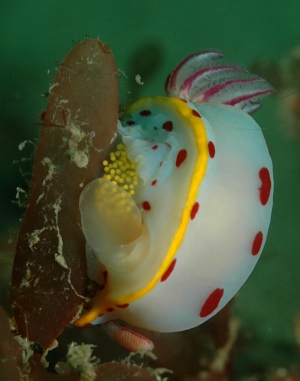
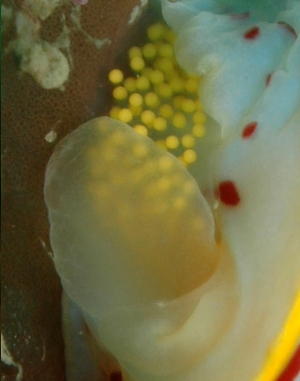
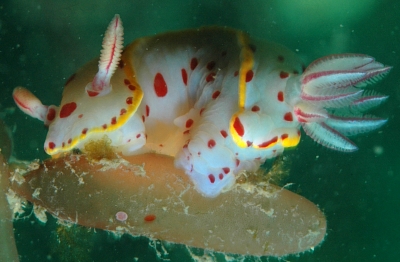
Dear Leanne & David,
It's nice to have a photo of the egg ribbbon, especially when the animal is actually in the process of laying it. Although I know from experience that this is its egg ribbon it is good to have 'visual proof'.
Best wishes,
Bill Rudman
Re: Hypselodoris bennetti & Ceratosoma amoena
June 22, 2007
From: Leanne & David Atkinson
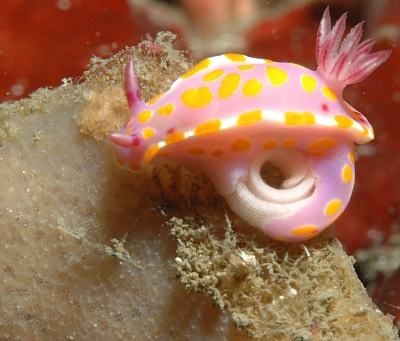
Concerning message #19437:
Dear Bill,
Re: message above by Lynda Clarke on Hypselodoris bennetti and Ceratosoma amoena together. We have seen this on a number of occasions at Port Stephens as well. The most recent was on a spade-shaped sponge. There were four nudibranchs on the one sponge, 2 of each type. There were two together on the side and a Ceratosoma amoena laying eggs a bit further down the edge of the wide part of the sponge. Another Hypselodoris bennetti was starting to climb up the stalk. Despite being in 28 metres it was fairly surgey and we needed to hold the sponge to stop it moving and allow focussing. The two that had appeared to be feeding reacted to the sponge being held and moved their heads, hence no positive feeding shots.
Locality: Little Island, east of the mouth of Port Stephens, 28 metres, New South Wales Australia, Pacific, 15 April 2007, Rocky Reef with sponges, ascidians, gorgonias and black coral. Length: approximately 40 mm. Photographer: Leanne & David Atkinson.
Regards,
Leanne & David Atkinson
atk@hunterlink.net.au
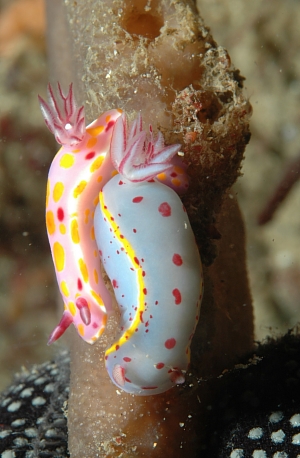
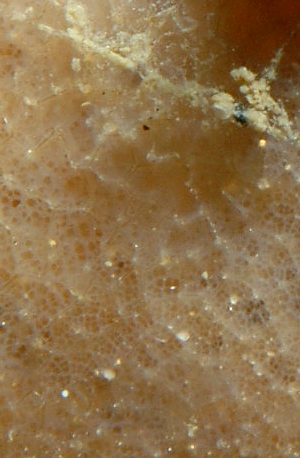
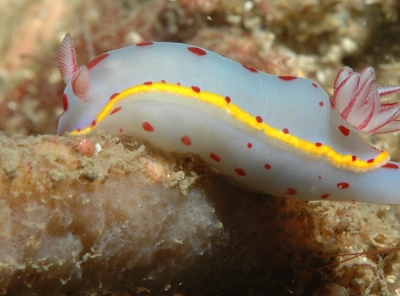
Dear Leanne & David,
Thanks for this record - though I am not sure what it is a record of. In Lynda's earlier message the Hypselodoris seems to have its oral tube out, suggesting that it is feeding on the Psammocinia but I don't know whether the Ceratosoma is just 'watching' or eating as well. I think the sponge in your message here is a species of Semitaspongia which is a genus of sponges we often find Ceratosoma amoena feeding on but until now the only feeding records for H. bennetti have been from Psammocinia. So the question here must be is H. bennetti just 'watching'.
Hypselodoris bennetti is a bit of a puzzle because most species of Hyspelodoris feed on sponges of the Dysideidae, while it alone feeds on a species in the Irciniidae. Interestingly, Semitaspongia is in the family Thorectidae and there is one Mediterranean Hypselodoris which feeds on a thorectid, so if H. bennetti also eats Semitaspongia it wouldn't be totally outrageous. I mention all this, not because I want to confuse you, but to show that accurately finding the prey of each species is giving us an interesting insight into relationships.
High resolution photos like this which allow us to see sponge structure are very valuable. It is also useful to include a photo of the sponge colony. But as you note, we need a positive feeding shot, to resolve puzzles like this. Some people have asked me what about studying stomach contents? The problems with chromodorids is that they feed on groups of sponges which lack mineral spicules in their skeletons so there is nothing in the stomach contents to identify. You can certainly find some sponge spicules in chromodorid stomachs from a vast variety of sponge families but that is because the sea floor is littered with stray sponge spicules which are ingested as an animal feeds on its chosen food. Even herbivores have been reported to eat sponges when the presence of such spicules in stomach contents are misinterpreted.
Best wishes,
Bill Rudman
Hypselodoris bennetti & Ceratosoma amoena
February 12, 2007
From: Lynda Clarke
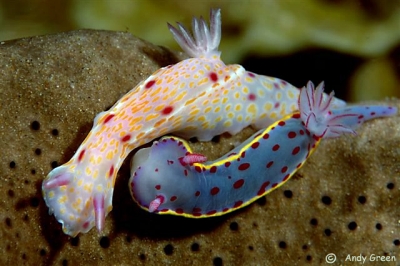
Dear Bill,
We found these two nudibranchs on Friday, both species are common at Julian Rocks. The blue Hypselodoris bennetti, is usually found either alone or mating, which they seem to do a lot of. Even when there are several on the same sponge they are usually quite separate. Ceratosoma amoena is also quite common, but usually alone. I thought the close proximity of these two was interesting.
Locality: Julian Rocks, 10 to 15 metres, New South Wales, Australia, Pacific, 9 February 2007, rocky reef. Length: less than 3cms. Photographer: Andrew Green.
Kind regards
Lynda
polymath@bigpond.com
Clarke, L, 2007 (Feb 12) Hypselodoris bennetti & Ceratosoma amoena. [Message in] Sea Slug Forum. Australian Museum, Sydney. Available from http://www.seaslugforum.net/find/19437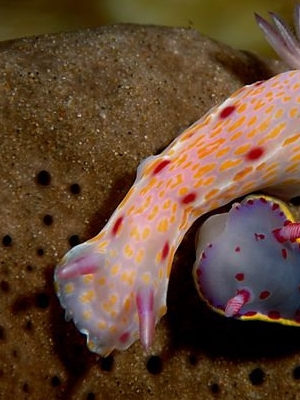
Dear Lynda (& Andrew),
Thanks for the photo. The sponge these animals are on is an irciniid of the genus Psammocinia, which gets its name from psammo the ancient Greek word for sand. You will note in the photo how there are sand grains embedded in the tissue of the sponge, and this is a characteristic of species of this genus. From earlier records I am pretty sure that species of Psammocinia are the preferred food of Hypselodoris bennetti, and in your photo the oral tube seems to be partially everted suggesting it may be feeding. However from most preious records I am pretty sure that Ceratosoma amoena feeds on sponges of the family Thorectidae. You seem to suggest in your message that you often find it on Psammocinia. If so I would like some other photos to confirm this - especially if they show signs of feeding. There is an earlier message from Sue Newson [# 9843] showing C. amoena on a colony of Psammocinia, but the close-up showing feeding seems to be of a thorectid sponge. It's possible they could feed on both, but it would be nice to have some conclusive evidence. So any photos you think might help, would be very welcome
Best wishes,
Bill Rudman
Hypselodoris bennetti mating on sponge
January 21, 2004
From: Sean McMahon
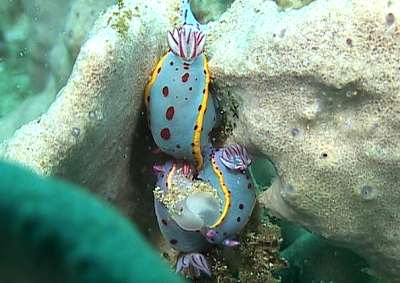
G'day,
Here is an interesting photo of mating Hypselodoris bennetti. It is from Oak Park, Cronulla [Sydney, NSW, Australia].
Regards,
Sean.
16a@l52.navy.gov.au
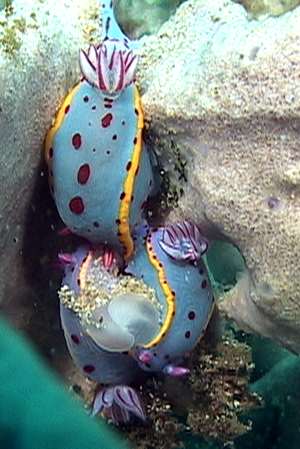
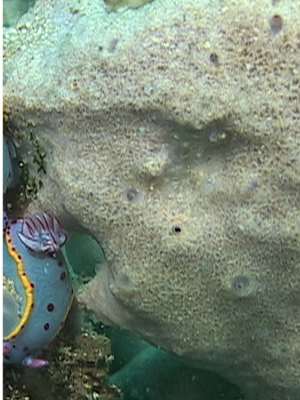
Thanks Sean,
Definitely 'two's company, three's a crowd'. As in the case of your message about Ceratosoma amoena, this photo is also an interesting sponge record. I am pretty sure this is its food sponge Psammocinia sp., so another record of the association is valuable.
Best wishes
Bill Rudman
Hypselodoris bennetti mating
January 21, 2004
From: Leanne & David Atkinson
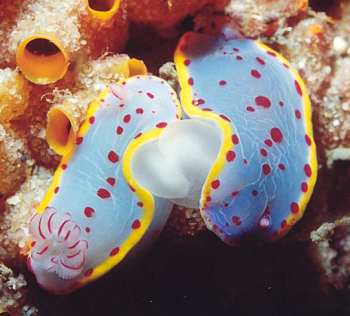
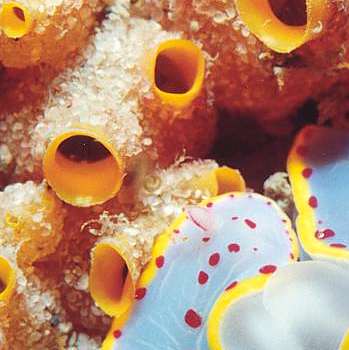
Dear Bill,
We were suprised at how few photos of Hypselodoris bennetti there were on the Forum. I guess because they are so common locally that people tend to ignore them. Here are some photos of them mating to add to the collection.
This one was taken at Fly Point Marine Reserve, Port Stephens, New South Wales, Australia. They would have been taken on the high tide. Other details weren't recorded.
Yours sincerely,
Leanne & David Atkinson
atk@hunterlink.net.au
Atkinson, L. & D., 2004 (Jan 21) Hypselodoris bennetti mating. [Message in] Sea Slug Forum. Australian Museum, Sydney. Available from http://www.seaslugforum.net/find/11887Thanks Leanne & David,
Bill Rudman
Hypselodoris bennetti - breeding season?
January 20, 2004
From: Sascha Schulz
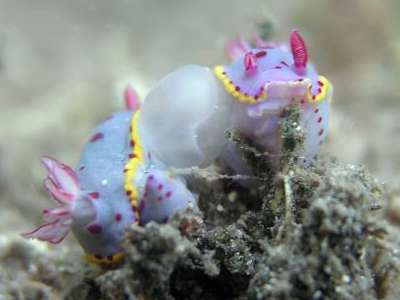
This photo of Hypselodoris bennetti mating was taken in Bushrangers Bay, a Marine Reserve near Wollongong.[New South Wales, Australia]
Depth is about 1m, there were two mating pairs and several indivudals spread around on a sandy, weedy slope. Glossodoris atromarginata was also common in the same area.
Does H. bennetti have any particular breeding season or are there other breeding triggers? Water temperature perhaps?
Sascha Schulz
ss31@wollongong.apana.org.au
Schulz, S., 2004 (Jan 20) Hypselodoris bennetti - breeding season?. [Message in] Sea Slug Forum. Australian Museum, Sydney. Available from http://www.seaslugforum.net/find/11948Dear Sascha,
Whether or not H. bennetti has a particular breeding season is a very good question which I'm afraid we don't know the answer to. In fact we know very little about the life histories and basic biology of most sea slugs. Many species seem to breed during the summer months, often starting with an early spring breeding period [August, September] and sometimes with a second peak in late autumn. Some species, such as Chromodoris tasmaniensis do the opposite, being most common in the cooler half of the year.
But this is just 'anecdotal' information. What we need is some rigorous recording of population numbers, sizes, egg laying etc of various species over a number of years.
Best wishes
Bill Rudman
Hypselodoris bennetti feeding
January 15, 2004
From: Leanne & David Atkinson
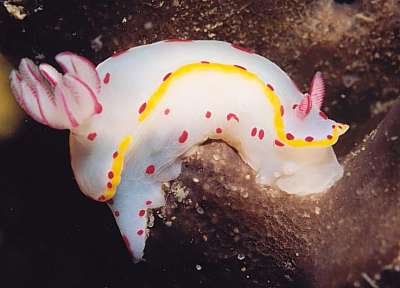
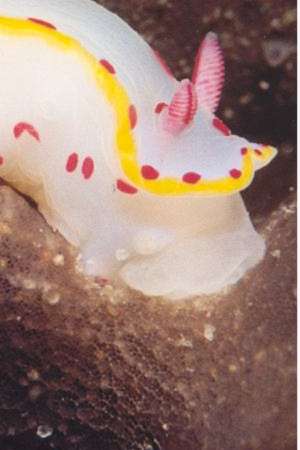
Dear Bill,
The following photographs have us confused. At the time I shot them I had noted the slugs as Hypselodoris bennetti. When the photos came back and the body appeared more white than blue we wondered whether they were Chromodoris splendida. Whatever it is, it is eating a grey sponge. There were Ceratosoma amoena feeding on the same sponge.
Date: 26 December 2003
Locality: Fly Point, Marine Reserve, Port Stephens, NSW, Australia.
Time: 12:00pm Tide: High, 1.9m
Depth: 8m
Length: 30mm
Thanks for your help,
Yours sincerely,
Leanne & David Atkinson
atk@hunterlink.net.au
Atkinson, L. & D., 2004 (Jan 15) Hypselodoris bennetti feeding. [Message in] Sea Slug Forum. Australian Museum, Sydney. Available from http://www.seaslugforum.net/find/11885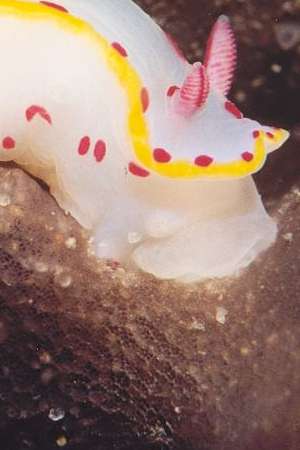
Dear Leanne & David,
Thanks for these photos. It is certainly a pale animal, but definitely Hypselodoris bennetti. I know its a bit of a circular argument but this is the sponge H. bennetti feeds on and certainly not one that C. splendida eats. More importantly, the position of the reddish spots on the mantle - particularly touching the yellow border, and the colour of the gills and rhinophores is typical of Hypselodoris bennetti
Best wishes
Bill Rudman
Hypselodoris bennetti from Jervis Bay
September 8, 2003
From: Sue Newson
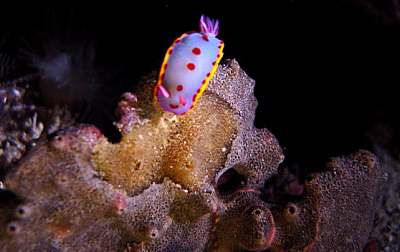
I captured this Hypselodoris bennetti during a night dive on the 23rd August 2003 at 'The Docks', Jervis Bay, at a depth of 20m [New South Wales, Australia].
I thought you may find it of interest. Its been very quiet in regards to nudibranchs in Jervis Bay for awhile now.
regards
Sue
snewson@shoal.net.au
Newson, S., 2003 (Sep 8) Hypselodoris bennetti from Jervis Bay. [Message in] Sea Slug Forum. Australian Museum, Sydney. Available from http://www.seaslugforum.net/find/10910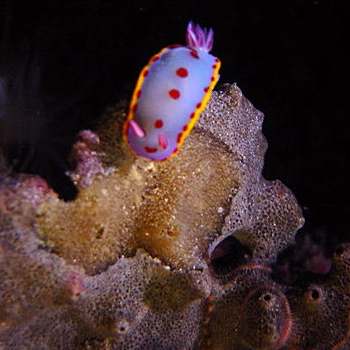
Thanks Sue,
Any feeding records are of interest. You can see in your photo the large yellow-brown area where the slug has been scraping off the reddish outer layers of the sponge colony. I am pretty sure the sponge is the species of Psammocinia that I have reported it feeding on before. If so it is excellent confirmation of at least one of its food sponges
Best wishes
Bill Rudman
Hypselodoris bennetti from nthn New South Wales
June 27, 2002
From: David Wachenfeld
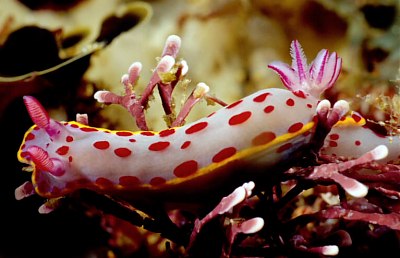
Hi Bill
Many thanks for your recent help in identifying a photo of Chromodoris splendida that I took at Julian Rocks [nthn New South Wales, Australia] in December. The attached photo was taken at the same time. I'd be very grateful if you could provide an id. Can you recommend any good field guides for nudi's in this area? I have a number of invertebrate field guides, including the Helmut Debelius book on nudibranchs and sea snails, but I haven't been able to find a match for this species. If you can recommend a good book, I might not have to bother you again!!
Thanks again.
Cheers
David
triggerfish@bigpond.com
Wachenfeld, D., 2002 (Jun 27) Hypselodoris bennetti from nthn New South Wales. [Message in] Sea Slug Forum. Australian Museum, Sydney. Available from http://www.seaslugforum.net/find/7363Dear David,
Don't feel as though asking questions is a bother. Your earlier message with the photo of the 'one-spot' form of C. splendida on its food sponge is a good example of why I welcome questions and photos, even of things that are relatively common. Your photo was one of the few recorde we have of that form of C. splendida feeding so is a valuable piece of information. I would rather I was sent ten 'boring' identifications than lose an important piece if information like that.
Your animal is Hypselodoris bennetti. It is quite common in eastern Australia, restricted mainly to the New South Wales coast, although there are occasional finds in Victoria and southern Queensland. Concerning books, have a look at the Book List for information on most available books on Sea Slugs.
Best wishes,
Bill Rudman
Hypselodoris bennetti from New South Wales
March 10, 2002
From: Stuart Hutchison
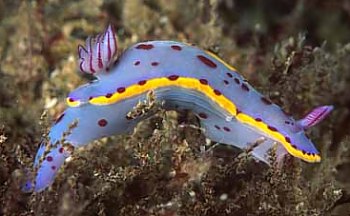
Hi Bill,
here's Hypselodoris bennetti from Tathra, New South Wales, Australia on 23 Apr 2000. Length 50mm. Depth 8m.
Regards,
Stuart
stuart@stuarthutchison.com.au
Hutchison, S., 2002 (Mar 10) Hypselodoris bennetti from New South Wales. [Message in] Sea Slug Forum. Australian Museum, Sydney. Available from http://www.seaslugforum.net/find/6306Thanks Stuart,
Bill Rudman
Hypselodoris bennetti from Sydney
June 13, 2000
From: Akos Lumnitzer
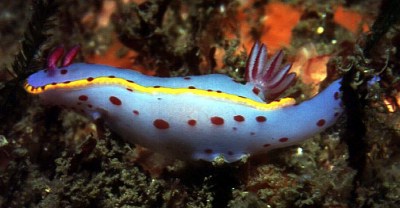
Hi Bill,
Here is a photo of Hypselodoris bennetti from Shark Point, Clovelly, Sydney.[NSW, Australia]. September 1998, 15 meters of water.
Akos
akos72@hotmail.com
Lumnitzer, A., 2000 (Jun 13) Hypselodoris bennetti from Sydney. [Message in] Sea Slug Forum. Australian Museum, Sydney. Available from http://www.seaslugforum.net/find/2553Thanks Akos,
Bill Rudman.
Hypselodoris bennetti from Sydney
August 9, 1999
From: Betsey Hansen
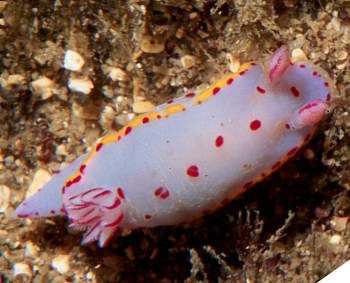
Bill,
I have attached a slide of what I believe is Hypselodoris bennetti. Can you please confirm this. This picture was taken in 1996 at Inscription Point, Botany Bay, Sydney, Australia.
Betsey
Elizabeth.P.Hansen@chase.com
Hansen, E.P., 1999 (Aug 9) Hypselodoris bennetti from Sydney. [Message in] Sea Slug Forum. Australian Museum, Sydney. Available from http://www.seaslugforum.net/find/1151Dear Betsey,
Yes this is Hypselodoris bennetti.
Bill Rudman.
